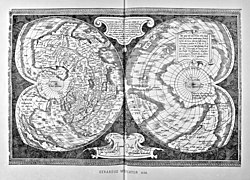Quam hic vides orbis imagine(m) lector ca(n)dide ea(m) ut posteriore(m) ita ^ eme(n)datiorem ijs que(...) - Norman B. Leventhal Map Center at the BPL
Autor/Urheber:
Attribution:
Das Bild ist mit 'Attribution Required' markiert, aber es wurden keine Informationen über die Attribution bereitgestellt. Vermutlich wurde bei Verwendung des MediaWiki-Templates für die CC-BY Lizenzen der Parameter für die Attribution weggelassen. Autoren und Urheber finden für die korrekte Verwendung der Templates hier ein Beispiel.
Shortlink:
Quelle:
Größe:
1200 x 783 Pixel (376802 Bytes)
Beschreibung:
Zoom into this map at maps.bpl.org. Author: Salamanca, Antonio Publisher: [s.n.] Date: [ca. 1550]
Scale: Scale not given ;
Call Number: G3200 1550.S25
Lizenz:
Relevante Bilder
Relevante Artikel
Mercator-Weltkarte von 1538Die Mercator-Weltkarte von 1538 gilt als eine der frühesten Werke des Kartografen Gerhard Mercator in seiner Zeit in Löwen. Die Karte wurde in herzförmiger Projektion geschaffen und bezeichnet erstmals Nord- und Südamerika einheitlich als Doppelkontinent Amerika. .. weiterlesen

